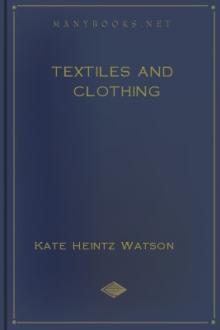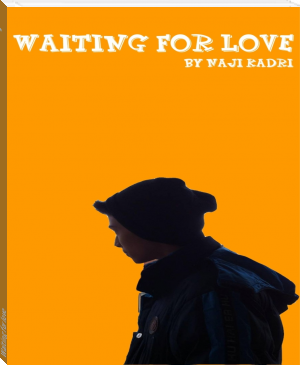Textiles and Clothing, Kate Heintz Watson [best ebook reader for laptop .txt] 📗

- Author: Kate Heintz Watson
- Performer: -
Book online «Textiles and Clothing, Kate Heintz Watson [best ebook reader for laptop .txt] 📗». Author Kate Heintz Watson
Placing of goods.
Pinning on of pattern so there is no waste.
Cutting.
Removing and care of patterns.
Pinning, basting, or tacking of skirt to lining.
Joining of seams, fitting.
Stitching.
Pressing.
Finishing of seams and placket hole.
Making and putting on waist-band.
Marking length and finishing the bottom.
Fastenings, loops, braids, hooks and eyes.
To lengthen or shorten a skirt pattern, measure the figure and regulate the length of the patterns by making a fold in each gore two-thirds of the way from the top of the pattern if too long. This is for the simplest skirt pattern. The shape of the skirt may require two folds, one two-thirds from the top and a small fold near the bottom to preserve the outline.
If too short pin the pattern on the material, cut around the top of gore and on each side two-thirds of the distance from the top of gore. Unpin and draw the pattern down to the bottom and cut the required length. Except for wash material, do not turn a gored skirt up at the bottom to form a wide hem, as the fullness made by turning is hard to dispose of neatly and the right curve at the bottom of the skirt may be lost.
Another way to lengthen the pattern is to cut it in two, two-thirds the distance from the top. See that all pleats or tucks are exactly the same width and at the exact distance from the top or bottom of the gore, also that all seams are of the right length. A shorter skirt must be proportionately narrower.
It is well to test the skirt and waist patterns by using inexpensive materials, such as calico, gingham, or cheap lining. Cut, baste, fit, and make this as carefully as if it were the best cloth or silk. If the skirt and waist are satisfactory, the pattern will do duty for several seasons. The plain waist pattern is the foundation for any waist and many changes can be made easily with a well-fitting skirt and plain waist pattern as a basis.
As paper patterns soon wear out, after a waist and skirt have been perfectly fitted, it is a good plan to cut an exact pattern of cambric, both skirt and waist, tracing seams and notching the parts. This will enable the home dressmaker to cut and make all ordinary dresses with little trouble and with but one trying on. It is always well to try on once, as materials differ in texture and a slight change may be necessary.
If the material is plain, has no nap, or if the design is perfectly symmetrical, the gores may be alternated, the top of one gore coming opposite the bottom of the next. The half pattern of the front gore is always laid on a lengthwise fold of the goods. If the goods is wide, the other gores may be cut double with the cloth folded lengthwise. With narrow goods, the cloth may be folded end to end after the middle gore has been cut out, and the other gores cut double. Care should be taken that the line of holes in the middle of the gores runs exactly in a line with the warp of the material, i. e., parallel to the selvage.
If the goods has a figure, the design should run upwards. Any nap should run downward, except with velvet or velveteen, in which it should run upwards. With such goods, the gores if cut double must be placed on a lengthwise fold, with the lengths running the same way. If the goods is narrow, the gores may have to be cut single, reversing the pattern (turning it over) so that both pieces may not be for the same side.
Pin the middle of the pattern to the goods and smooth towards each end, pinning securely at top and bottom. Avoid too many pins and pin carefully, otherwise the pattern will be displaced.
After the pattern is securely pinned, cut out the gores, using long, sharp shears. Care should be taken not to lift the material from the table, not to have jagged, uneven edges, as both time and material will be wasted in straightening them. Open the shears as wide as possible, taking a long sweep of the material, and do not allow the points of the shears to come together. Mark all notches with basting thread, tailor's chalk, or notch the goods if it does not ravel.
The back gores should be cut in the same way. They are usually wider than the front gores and may require piecing, which should be done along the warp threads.
Now remove the pattern, pin carefully all pieces together and fold as little as possible. The trinity—pin, baste, press—should be written in large letters in every sewing room, for much of the beauty of the gown depends upon these three.
To join the skirt, pin the side gores to the front gores, beginning at the top, with pins running across the seams, then begin at the top of the skirt and baste downward, allowing all unevenness to come out at the bottom. Baste straight and evenly, taking one stitch at a time. Several stitches should never be taken at once on thick or piled goods, as the side next to the sewer is apt to be fuller in that case. When all seams are basted, try on the skirt and make all changes necessary before stitching. Both the outside skirt and any under or "drop" skirt should be fitted as carefully as a waist.
If the skirt is to be lined the lining should be made and fitted first, then ripped and the outside carefully basted on the lining, being well stretched over the lining, care being taken to have the warp of the outside and the lining run the same way. This will prevent the lining from drawing the goods.
A stitch of medium length should be used on all seams whether white goods or cloth. If the stitch is too long, the seam will "gap" and will show the thread; if too short, the seam is apt to draw. The line of stitching must be absolutely parallel inside or outside of the basting or the curve will be ruined. Use silk or the best cotton for stitching skirts and be sure that the needle is not too coarse.
After stitching, all bastings along the seams should be taken out by cutting the thread in several places. Never pull a basting the length of the skirt. The seams should be opened and pressed according to directions. The seams may be finished with a taffeta binding, overcast, stitched flat or notched, as the case demands.
If stiffening is used at the bottom of a lined skirt it should be fitted to each lining gore separately and securely stitched. A light weight canvas should be stitched to a heavy cloth skirt at the bottom, if several rows of stitching or braid are to finish the bottom of the skirt.
The placket may be finished before the two back gores are pinned to the front, if preferred. If done before joining the gores the placket can be pressed better and the front is not so liable to be crushed. On the left side of the skirt sew an underlap of sufficient length to extend well below the end of the opening. Face the right side of the opening with a piece of the goods, or tape not too wide, hem or cat-stitch to the skirt, and finish with hooks and eyes, loops, or any fastening that will secure the placket.
The skirt is now ready for the band, which should be narrow. Always cut parallel with the selvage and the length of the underlap longer than the waist measure, allowing for turning at the ends. The band should never be thick and clumsy and not too tight. Try on the skirt and fit the band carefully, marking the seam with pins, a line of basting, or chalk. Hold the skirt easy on the band and baste with small stitches, then stitch on the machine. If the skirt is too tight around the hips the plaits will fall apart at the back. If the skirt is stretched on the band the seams will not fall in a straight line. After the band is securely stitched and finished with hooks and eyes adjust the length by turning under at the bottom and pinning, after which baste all around and try on again to make sure that the length is correct.
A gored outside garment should be finished with a true bias or a fitted facing, carefully stitched on. It is possible to finish the bottom of a simple house dress or thin skirt with a hem if the fullness made by turning is disposed of in gathers or fine pleats. A bias facing, however, is always preferable. If of heavy or lined goods the finish should be velveteen or braid the same color as the skirt. These bindings come in different widths and grades. Braids should always be shrunken by wetting and drying thoroughly; one wetting is not enough. Velveteen should be applied loosely, so as not to shrink or draw after it becomes damp on the skirt.
The right side of the velveteen should be carefully basted with small, even stitches to the edge of the facing. It may be hemmed to the facing or machine stitched just inside the basting, which need not be removed. It is then turned, allowing a very narrow portion to show below the edge, and basted with close stitches, pressed, hemmed down to the facing by hand, or cat stitched without turning the edge. Be careful not to let the stitches show on the right side, nor let the binding twist or pucker. The joining of the velveteen should be near the seam in the back.
Another method is to cut off the bottom edge of the skirt a quarter of an inch from the turning line; apply the wrong side of the velveteen to the right side of the skirt, baste carefully close to the edge and stitch on the machine through velveteen, cloth, and lining (or facing) just inside the basting which is left in. The bottom of the raw edge is turned up, basted close to the edge allowing the velveteen to show a very little. The upper edge of the velveteen is secured as before by turning and hemming or catstitched without turning. The illustration shows this method of applying the velveteen which is first stitched to the lining and turned with the edge. This makes a firm, rather stiff finish.
Braid is stitched on to the bottom of a skirt with a narrow edge showing, or it may be applied like the velveteen, with a doubled edge at the bottom. The doubled edge will wear better.
Skirts that are to be washed and therefore which are very likely to shrink must be finished at the bottom with a wide hem—at least six inches—the fullness made by turning being disposed of carefully in pleats or gathers.
If desired, the bias seam down the back of the skirt may have a narrow woven tape or selvage of thin goods stitched in with the seam. This strengthens the seam and prevents dragging. The skirt





Comments (0)